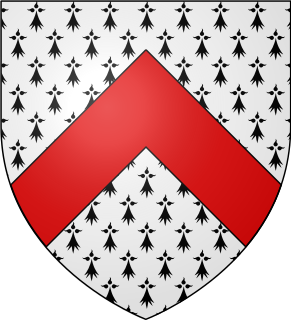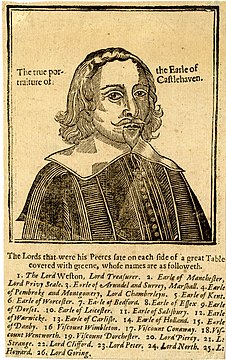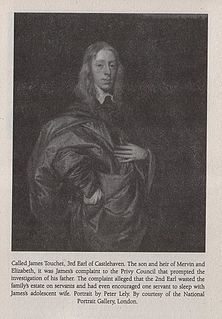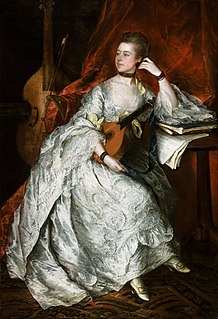Related Research Articles

Earl of Castlehaven was a title in the Peerage of Ireland, created on 6 September 1616. It was held in conjunction with the Barony of Audley, the Barony of Audley of Orier, and the Barony of Audley of Hely.

George Tuchet, 1st Earl of Castlehaven, was the son of Henry Tuchet, 10th Baron Audley and his wife, née Elizabeth Sneyd.

Mervyn Tuchet, 2nd Earl of Castlehaven, was an English nobleman who was convicted of rape and sodomy and subsequently executed.

James Tuchet, 3rd Earl of Castlehaven was the son of Mervyn Tuchet, 2nd Earl of Castlehaven and his first wife, Elizabeth Barnham. Castlehaven played a prominent role in the Wars of the Three Kingdoms that took place in the middle of the 17th century, and was particularly active in the conflicts in Ireland at this time.
John Talbot Tuchet, 8th Earl of Castlehaven was the son of James Tuchet, 6th Earl of Castlehaven, and his wife, née Elizabeth Arundell. He succeeded his brother as Earl of Castlehaven and Baron Audley on 6 May 1769.

Baron Audley is a title in the Peerage of England first created in 1313, by writ to the Parliament of England, for Sir Nicholas Audley of Heighley Castle, a member of the Anglo-Norman Audley family of Staffordshire.

The title Baron Berkeley originated as a feudal title and was subsequently created twice in the Peerage of England by writ. It was first granted by writ to Thomas de Berkeley, 1st Baron Berkeley (1245–1321), 6th feudal Baron Berkeley, in 1295, but the title of that creation became extinct at the death of his great-great-grandson, the fifth Baron by writ, when no male heirs to the barony by writ remained, although the feudal barony continued. The next creation by writ was in 1421, for the last baron's nephew and heir James Berkeley. His son and successor William was created Viscount Berkeley in 1481, Earl of Nottingham in 1483, and Marquess of Berkeley in 1488. He had no surviving male issue, so the Marquessate and his other non-inherited titles became extinct on his death in 1491, whilst the barony passed de jure to his younger brother Maurice. However William had disinherited Maurice because he considered him to have brought shame on the noble House of Berkeley by marrying beneath his status to Isabel, daughter of Philip Mead of Wraxhall, an Alderman and Mayor of Bristol. Instead he bequeathed the castle, lands and lordships comprising the Barony of Berkeley to King Henry VII and his heirs male, failing which to descend to William's own rightful heirs. Thus on the death of King Edward VI in 1553, Henry VII's unmarried grandson, the Berkeley inheritance returned to the family. Therefore, Maurice and his descendants from 1492 to 1553 were de jure barons only, until the return of the title to the senior heir Henry, becoming de facto 7th Baron in 1553. Upon his death he was succeeded by his relative George Harding.

Earl of Selborne, in the County of Southampton, is a title in the Peerage of the United Kingdom. It was created in 1882 for the lawyer and Liberal politician Roundell Palmer, 1st Baron Selborne, along with the subsidiary title of Viscount Wolmer, of Blackmoor in the County of Southampton. He had already been made Baron Selborne, of Selborne in the County of Southampton, in 1872, also in the Peerage of the United Kingdom. Both his son, the second Earl, and grandson, the third Earl, were prominent Liberal Unionist politicians. The latter was in 1941 called to the House of Lords through a writ of acceleration in his father's barony of Selborne. As of 2009 the titles are held by the third Earl's grandson, the fourth Earl. He is one of the ninety elected hereditary peers that remain in the House of Lords after the passing of the House of Lords Act 1999, and sits as a Conservative.

Baron Howard de Walden is a title in the Peerage of England. It was created by writ of summons in 1597 by Queen Elizabeth I for Admiral Lord Thomas Howard, a younger son of Thomas Howard, 4th Duke of Norfolk, by his second wife, the Honourable Margaret Audley, daughter of Thomas Audley, 1st Baron Audley of Walden.

James Tuchet, 5th Baron Audley, 2nd Baron Tuchet of Heleigh Castle was an English peer.
Anne Stanley was an English noblewoman. She was the eldest daughter of the Earl of Derby and through her two marriages first became Baroness Chandos and later Countess of Castlehaven. She was a distant relative of Elizabeth I of England and for some time was seen as a possible heiress to the English throne.

Captain Philip Thicknesse was a British author, eccentric and friend of the artist Thomas Gainsborough.
George Thicknesse, later Thicknesse-Touchet, 19th Baron Audley was an English peer.
Touchet is a surname, and may refer to:
James Tuchet, 7th Baron Audley was a leading rebel in the 1st Cornish Rebellion of 1497 opposing the rule of Henry VII of England. James Tuchet was born in Heleigh Castle, Staffordshire to John Tuchet, 6th Baron Audley and Anne Echingham. He was sentenced for treason and beheaded with the defeat of the Cornish Rebellion of 1497.
George John Thicknesse-Touchet, 20th Baron Audley.

John Tuchet, 8th Baron Audley, 5th Baron Tuchet was an English peer.
Antigone of Gloucester was an English noblewoman and the illegitimate daughter of Humphrey of Lancaster, 1st Duke of Gloucester (1390–1447). She was the granddaughter of King Henry IV. She is thought to have been born between 1425 and 1428. Her date of death is not known, but it was later than 1450.
References
- Leigh Rayment's Peerage Pages [ self-published source ][ better source needed ]
- ThePeerage.com entry
| Peerage of England | ||
|---|---|---|
| Preceded by George Edward Thicknesse-Touchet | Baron Audley 1937 (by writ) –1942 | Succeeded by Thomas Touchet-Jesson |
| This biography of a baron or baroness in the Peerage of England is a stub. You can help Wikipedia by expanding it. |